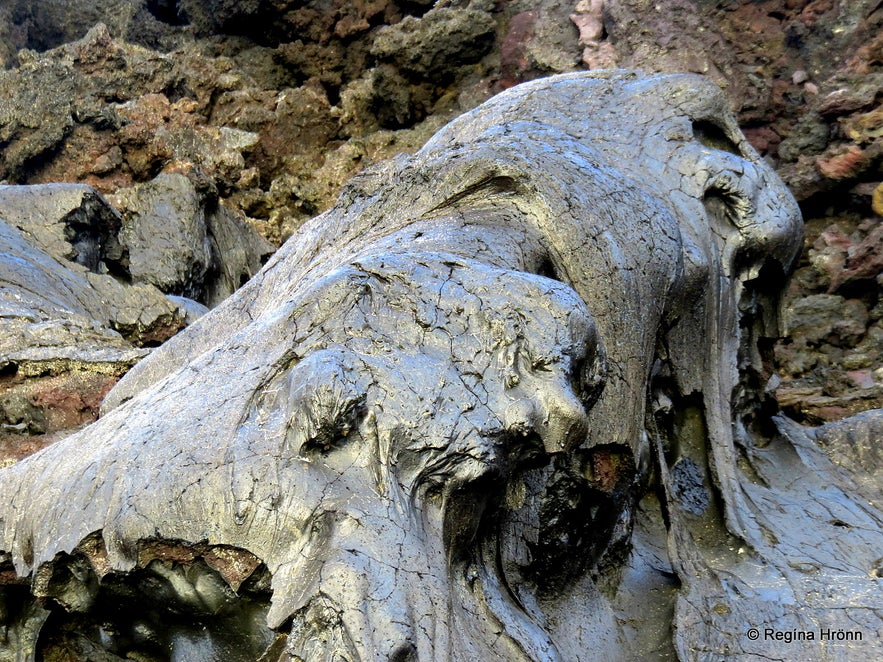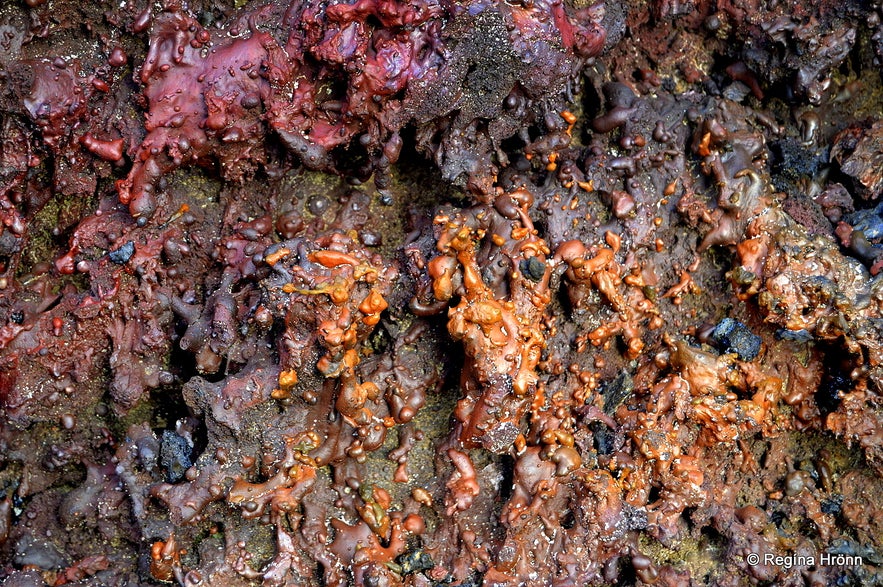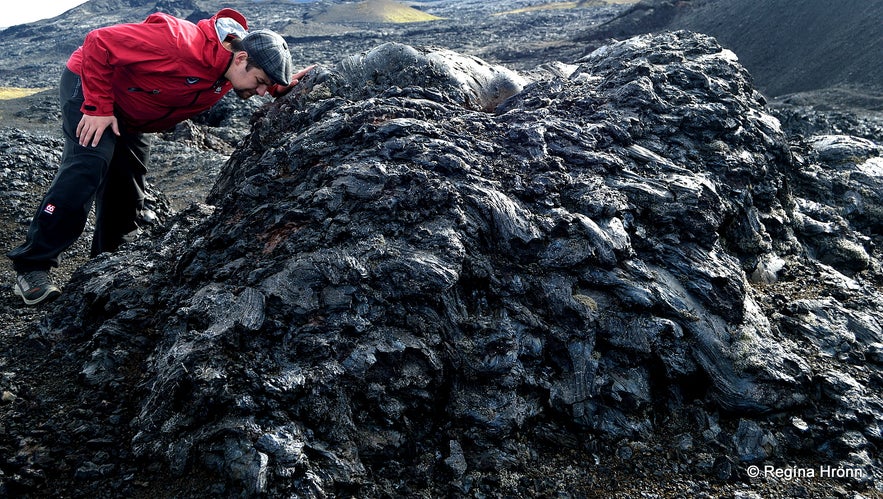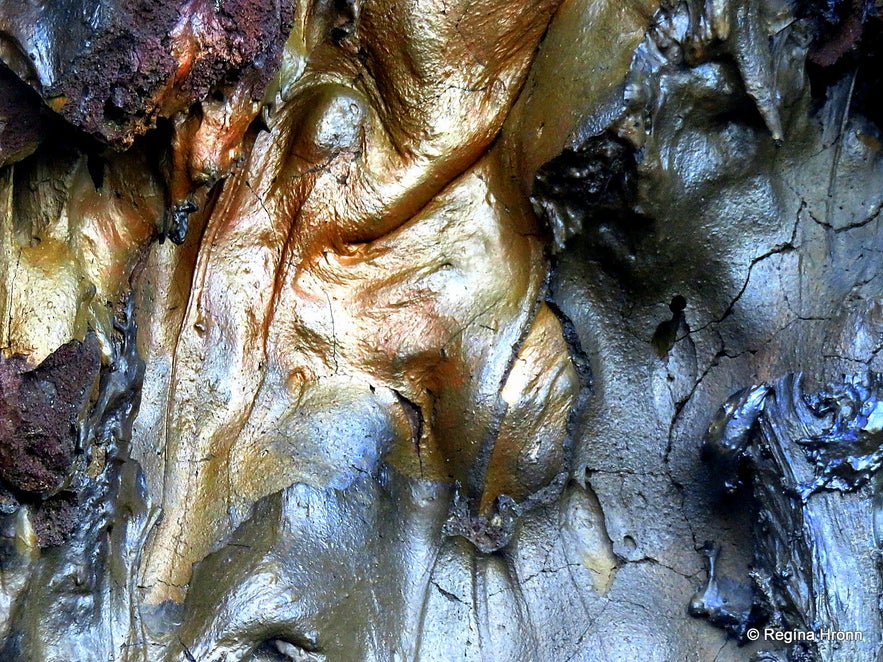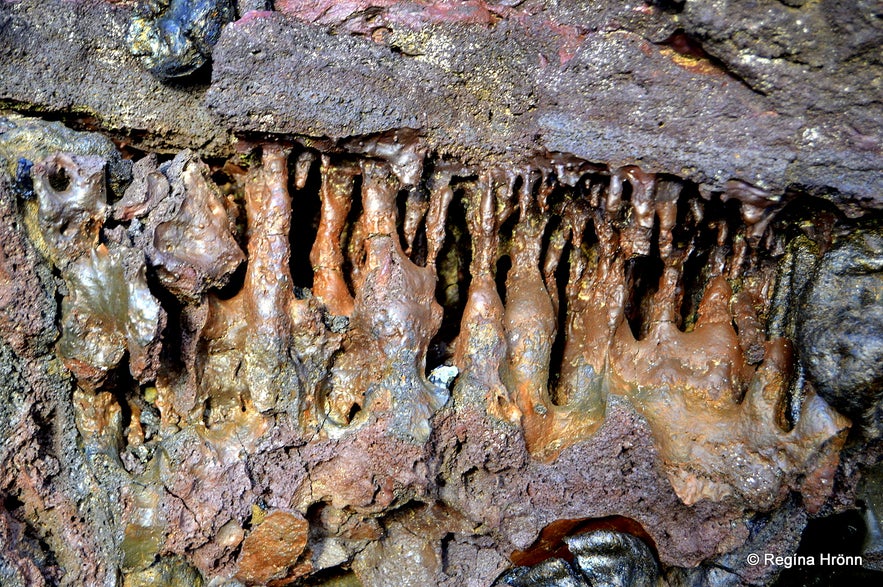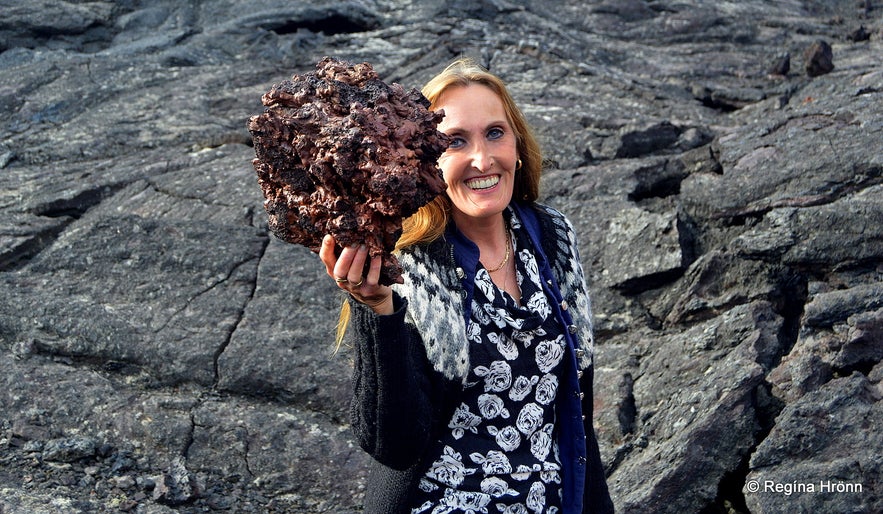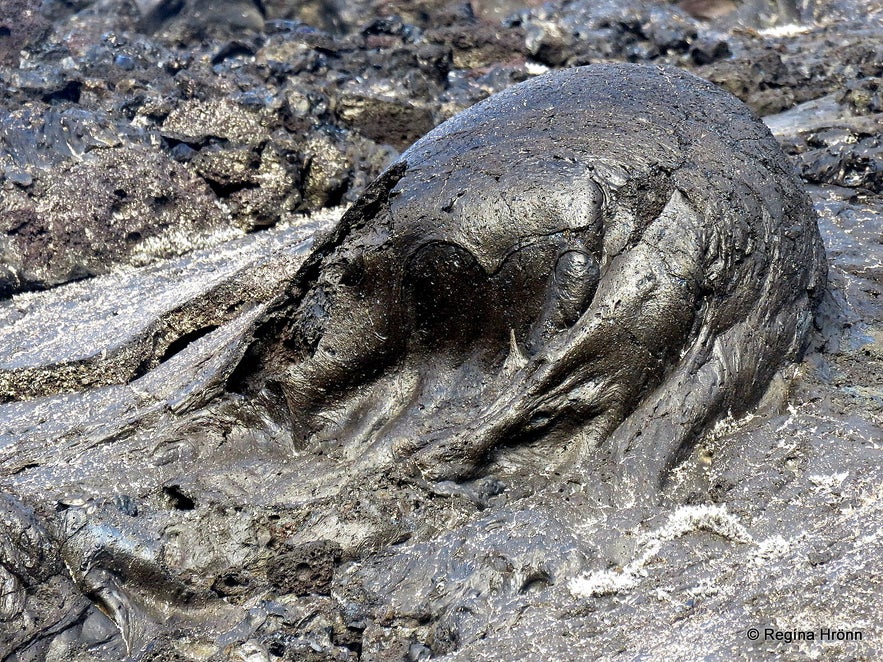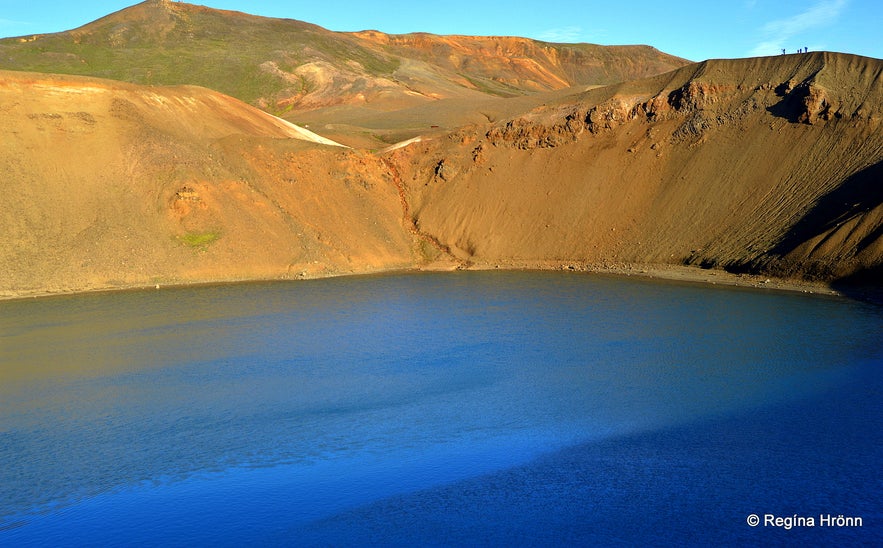
A Unique Lava Walk through the Colourful Lava Field at Gjástykki at Krafla in North-Iceland

I visited the extraordinary colourful lava field, Gjástykki, when I joined guided a tour of this area. At Gjástykki you will see newly created lava formations from the Krafla volcano-tectonic eruptions back in 1975-1984, called the Krafla Fires. I had never been there before so I was excited about visiting it.
I followed the Katla Fires on the news when I was younger and the name Gjástykki had always sounded so exotic to me. I had wanted to visit it for the longest time as I visit the Krafla area every year. So when I saw that there was a guided tour to Gjástykki I jumped at the chance of finally being able to visit it!
Top photo: Lava formations at Gjástykki

The Krafla area
To get to Gjástykki our very knowledgeable driver, Ingimar, drove through the ever so popular Krafla area. I love the colourful mud pools by Leirhnjúkur and Víti, but I had never gone further north in this area, so Gjástykki was an unknown area to me.
Leirhnjúkur and Gjástykki belong to the same volcanic zone and knowing how extraordinary Leirhnjúkur is I was eager to see what the almost untouched lava-field Gjástykki looked like.
We made our first stop by the information signs on top of the hill where there is an excellent view of the Krafla area and the Krafla geothermal power plant.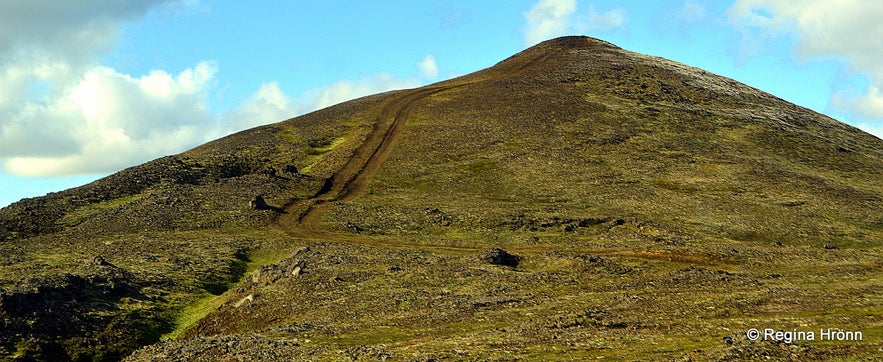
We took a detour up this hill
After a while, we left the paved road and turned onto a 4x4 bumpy dirt road. I love being driven around on such roads, but as I get carsick then I always sit in the front by the driver. If you have a tendency to get carsick ask the driver for permission to sit in the front. In my case, it makes all the difference.
We saw a tire track leading up a pretty steep hill and the driver asked us: "Now, are you ready to have some fun...?!!" and drove straight up the steep hill - with our permission of course.
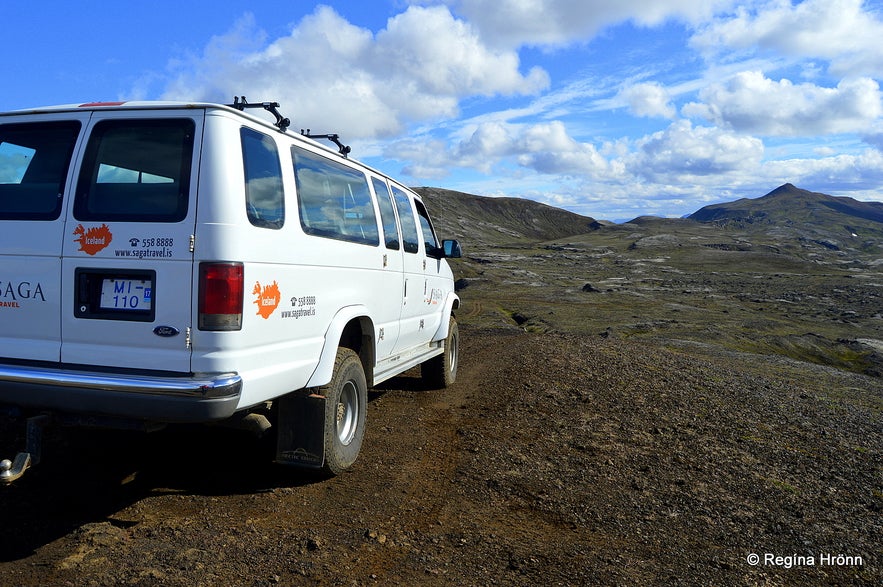
On the route to Gjástykki
On top of the hill, there is a very good view of the Krafla area. I loved it - the thing is that when I go on guided tours I feel like a kid and put all my trust in the guides. So fun stuff is always acceptable to me :)
We made a stop by another hill, Hreindýrahóll - Reindeer Hill, 3 km away from Víti, from where there is a beautiful view of the surrounding area.
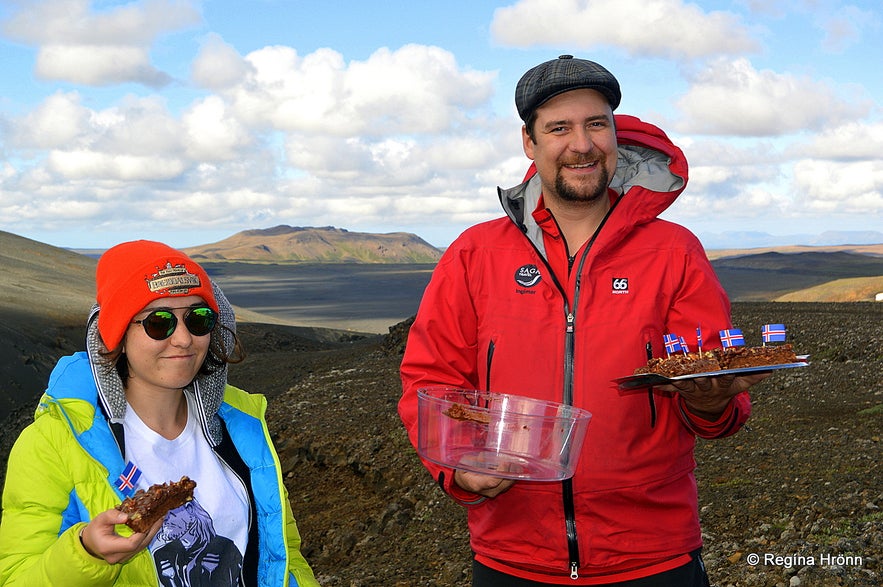
A birthday girl on the tour got a cake :)
At the next stop, our guide had a surprise from the tour guide for one of our passengers. They had got wind of the fact that a girl in the group was celebrating her birthday and had bought a birthday cake from Vogafjós restaurant by Lake Mývatn. We all got a piece of cake with the Icelandic flag on top :) I think this was a lovely gesture.
This is what I have noticed about the tour company, they specialised in slow travel with small groups which makes travelling with them feel like you are travelling with a friend. I have been on several of their tours and was excited about trying out more of their tours while I was staying up north for my summer vacation. 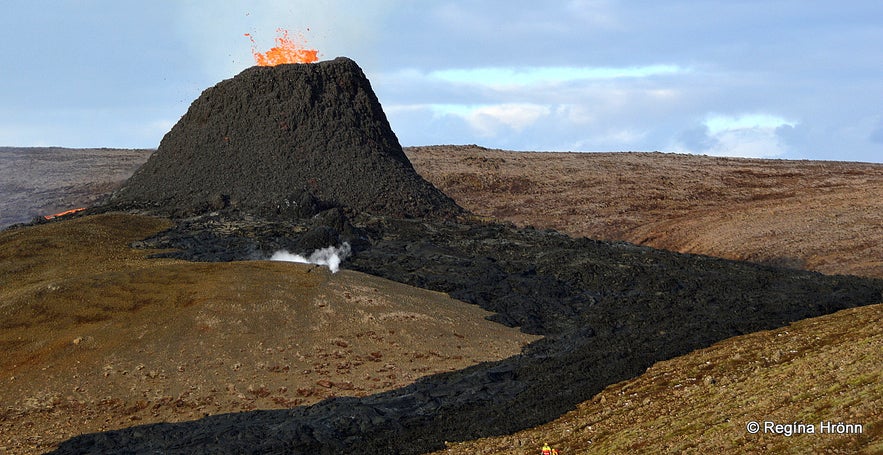
Geldingadalir volcanic eruption in SW-Iceland 2021
When we got to the main area of Gjástykki we could see from above the directions of the black lava flow and where it suddenly stopped in its tracks. The contrast between the black lava and the green grass was so evident here.
Just imagine all the grass and flowers that were smothered by the red-hot lava flow!
We now have our own volcanic eruption on the Reykjanes peninsula in SW-Iceland where the same thing is happening:
The Volcanic Eruption in Geldingadalir Valley on Reykjanesskagi in SW-Iceland

Geldingadalir volcanic eruption in SW-Iceland 2021
By now it was time to start our 1.5-hour-long hike in the Gjástykki rift valley. I was amazed by the stretch of the black lava and was pretty excited to see this area with my own eyes.
I know what there is to find in such areas - under the black layer of lava beautiful colours appear: blue, pink, orange, red and golden colours!
Colourful lava at Gjástykki
We first encountered something that looked like a dinosaur egg - I have visited several lava fields, but have not come across dinosaur eggs before! I saw an open "egg" in one place at Gjástykki and it was filled with the most colourful lava. It reminded me of a piñata :)
When I looked around I saw piles of lava with an opening on top - I think these are lava formations where gas had been trapped inside a bubble and the bubble had popped, so it was possible to see what they looked like on the inside.
Lava bubbles at Gjástykki
You can see our guide looking inside one of the bubbles - so we all followed suit and had a look inside.
There was a colourful opening at the top of the popped bubble and heat coming from it - giving away that the earth was still seething and bubbling down below.
The guide looking into an opening at Gjástykki
Gjástykki is off the beaten path and we were totally alone there - I felt like we had entered another dimension.
In Gjástykki you will see all kinds of lava formations - this type of lava is called slag. The reason why this area is visited with a local guide is that it is new lava, which is very sensitive and brittle.
There is such a thin crust on the lava that even though I tried to tread lightly I was afraid of breaking the crust and stepping through the lava. This thin crust eventually turns into lava sand.
Colourful shiny lava at Gjástykki
Gjástykki is a rift valley, which belongs to the Krafla volcanic system and is located between Krafla in the south and Kelduhverfi by the sea in the north. It belongs to the northern part of the fissure swarm of Krafla.
Gjástykki was formed in the massive Krafla volcano-tectonic eruptions in 1975-1984 when the earth ripped apart and spew fire and lava high into the air for years.
There were 9 fissure eruptions during these 9 years in which the Krafla Fires lasted and you will see lava from the Krafla Fires in the southern part of the rift valley of Gjástykki.

Lava formations at Gjástykki
I remember this time well from watching it on telly being totally flabbergasted at the sight of the rift of fire. I never knew back then that I would actually be walking on the lava field of this once blazing inferno.
The tectonic plates are active in this area and Gjástykki and the whole Krafla area is located on the border of the Eurasian and North-American tectonic plates.
I, being an Icelander and used to seeing lava in my country, was very impressed by the lava formations, the thin crust on top of the lava and the beautiful vibrant colours of the lava itself.
Lava formations at Gjástykki
I would imagine that geologists would have a field day here, being able to examine such new lava and how it affected the landscape - how the lava sculpted different formations - and to feel the heat coming from holes in the lava.
There is still geothermal heat in 2 out of 3 of the geothermal areas in the fissure swarm which was active at Gjástykki during the Krafla volcano-tectonic eruptions. The most northern part of the lava field is now cold, so to speak, but the two in the south still emit heat. If you look closely you will see steam coming from the hot underground area in some places.
Extraordinary lava formations at Gjástykki
There are 20 meters high lava walls on both sides of the Gjástykki rift valley, created by the massive volcanic eruptions when Gjástykki was ripped apart. The rift valley is 2-5 km wide and 40-50 meters deep.
Inside Gjástykki there are several fissures, in some of which molten lava flowed like a river of fire, leaving the riverbeds behind. It looks like there is still an active hot lava flow in my photo below, but this is solidified lava - an artwork of nature.
Lava formations and lava colours at Gjástykki
Gjástykki is one of its kind in Iceland and on footage from 1984 one can see how the tectonic plates moved and the earth was ripped apart, as it were. The Eurasian plate moved to the east and the North-American plate moved to the west and in the fissure between them molten lava welled up.
This eruption sure did increase our understanding of the tectonic plates. One of our best-known reporters, Ómar Ragnarsson, knows this area very well and protested ideas of a power plant project in Gjástykki explaining to them how priceless this unique lava field really is.
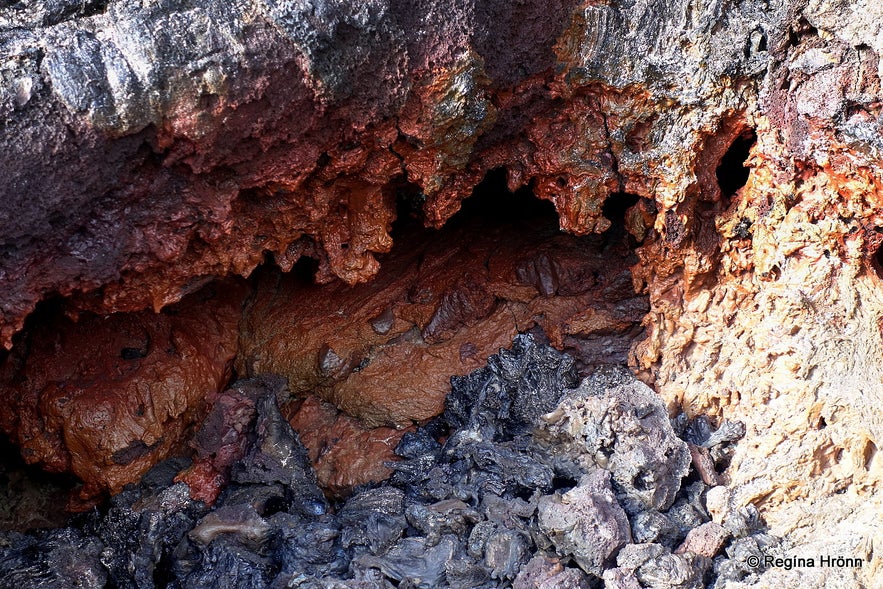
Colourful lava at Gjástykki
Ómar came up with the idea of walking around in Gjástykki holding a portable DVD player while watching the footage of the eruption since 1984. I think this is a great idea! Ómar has made many TV programs on Iceland and I own several of his fantastic DVDs on Iceland.
His enthusiasm and love for Iceland has been a great inspiration for me to explore and get to know my own country better. Kudos to him :) Gjástykki lava field is now preserved.
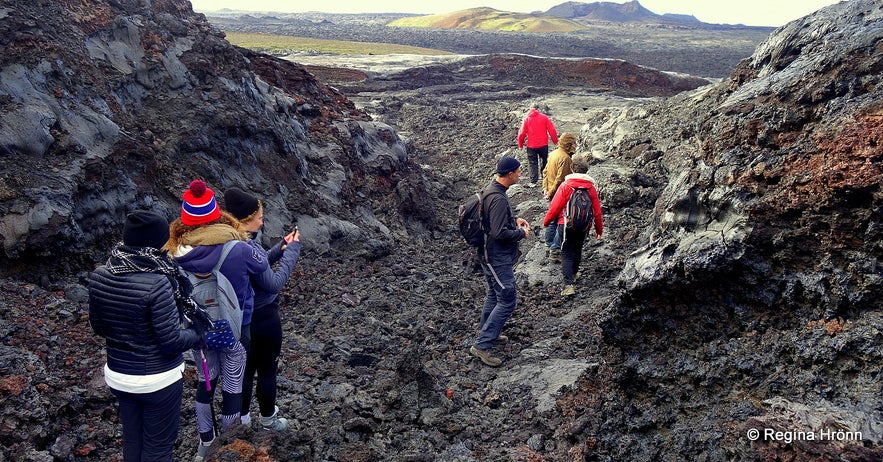
Hiking in Gjástykki lava field
The Krafla Fires lasted from the 20th of December 1975 until the 18th of September 1984. In the rift valley of Gjástykki, you will see many open lava rifts for which Gjástykki is known and which gave a name to the rift valley (the Icelandic word for a rift is "gjá" and "stykki" means a piece or a section).
Gjástykki lava field dates back to 1981-1984 when this northernmost part of the Krafla volcano-tectonic eruptions was most active.
In the south part of Gjástykki, you will see the small shield volcano Gjástykkisbunga, which is the only known volcano that has erupted in the rift valley.
Holding a very light lava rock at Gjástykki
The guide told us how the people living in and by Mývatn were severely affected by this 9-year-period of eruptions at Krafla, which is very close to the populated area of Mývatn.
We continued walking through the lava terrain. Everywhere I looked I saw amazing lava colours and formations. Lava is light and easy to pick up although new lava can be so sharp that it can hurt your hand.
At one point we had a "strong man competition" and took photos of us lifting "heavy" rocks ;) This lava is sharp and brittle so bring good walking shoes. The 1.5-hour-long hike through the lava field was easy, but it can be a tad taxing walking on lava for those who are not used to it.
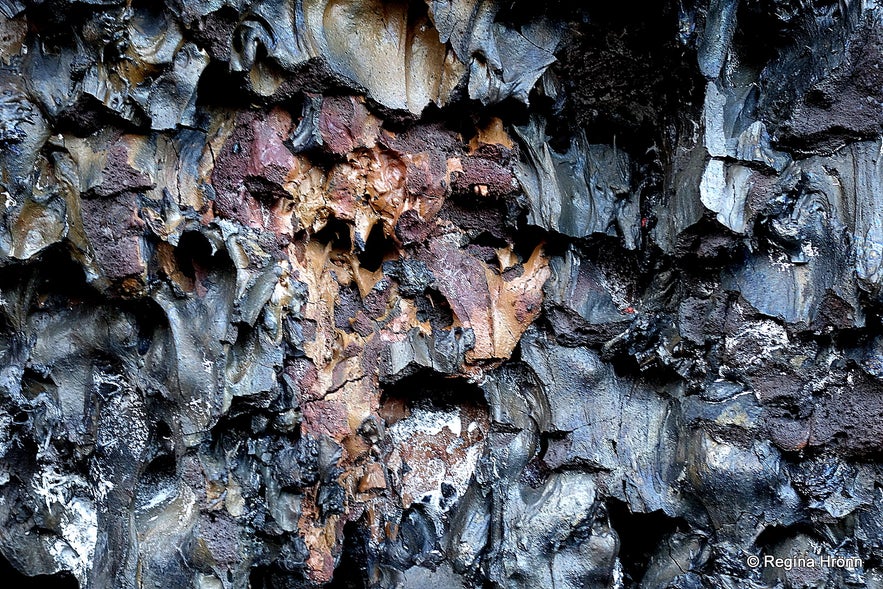
A colourful face in the lava at Gjástykki
My husband told me that he had found the phantom of Gjástykki! He is a kidder, but if you look at the photo above you can see a face with an open mouth!
Our guide also agreed on there being a face in the lava and took some photos to show to the guys at the office ;)
Strange lava formations at Gjástykki - it looks like a skull
As we carried on walking through the lava field we came across this almost creepy looking lava formation - to me, it looked like a skull that had been covered with semiliquid lava. It reminded me of photos I have seen from Pompei.
There were more strange-looking formations like this one, as you can see in my first photo.
On our way back we stopped by Víti or Hell, an explosion crater which was created in 1724-1729 during the volcano-tectonic eruptions called the Mývatn Fires. Víti is the Icelandic word for Hell as people often believed Hell to be located beneath volcanoes and one can imagine why when watching a volcanic eruption.
Stóra-Víti explosion crater
The explosion crater, or maar as it is also called, is filled with a lake, which in still weather is beautifully aquamarine in colour. If you look up one of my Mývatn travel blogs you will see a photo of the aquamarine lake. When it is windy the lake is royal blue in colour as you see in my photo above.
I thoroughly enjoyed hiking in the surreal lava field of Gjástykki - there was nobody around and we felt like we were on another planet. Highly recommended.
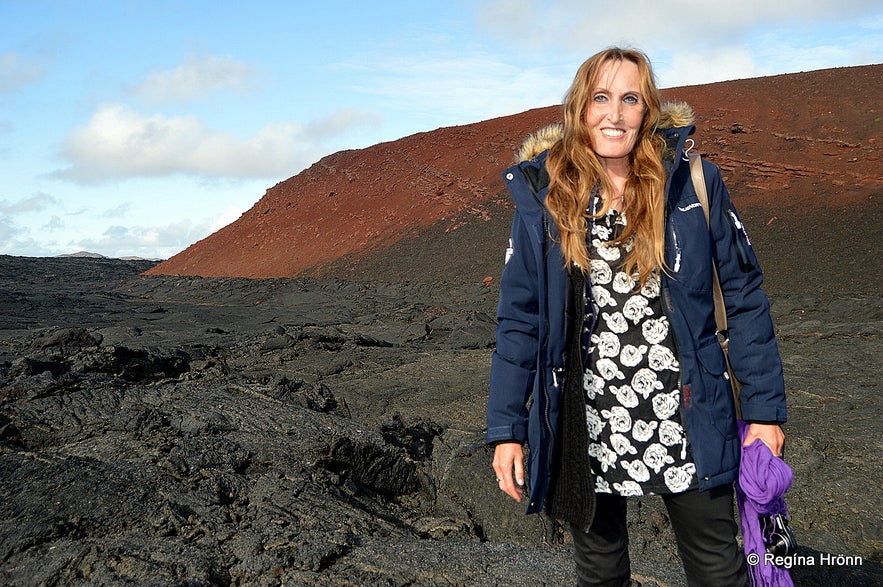
Surrounded by lava
The tour to Gjástykki started from the Mývatnsstofa information centre at 3 pm and lasted for 4.5 hours. Unfortunately, the tour I joined is no longer available.
I have joined several other tours of this area:
The Spectacular Diamond Circle in North-Iceland
A Unique Lava Walk through the colourful Lava Field Gjástykki at Krafla in North-Iceland
An Amazing Tour to Askja and Holuhraun Lava Field in the Highland of Iceland
A Wonderful Day of exploring the Mývatn Area in North-Iceland
To visit the north you can rent a car in Reykjavík and drive to Mývatn in two days.
Have a lovely time in North-Iceland :)
Andere interessante blogs
Noorderlicht in Ijsland
Als je nog nooit de kans hebt gehad om een ‘noorderlicht-show’ te zien en het één van je dromen is, dan is een reis naar Ijsland in de winter een echte aanrader. Het is geen garantie maar de kans beLees verderReizen naar IJsland per boot
Ik ben eind mei 2017 naar IJsland geemigreerd en ben met mijn eigen auto en de boot gegaan. Wat mij opviel is dat hierover heel erg weinig te vinden is qua reizigers ervaringen. Vandaar dat ik heb besLees verderGeitenboerderij Háafell
Ik geef het eerlijk toe, ik wist tot 2 jaar geleden ook niet van het bestaan van de IJslandse geit af. Totdat ik hoorde dat er 200 geiten op de nominatie stonden om geslacht te worden omdat in IJslandLees verder

Download het grootste reisagentschap van IJsland op je telefoon en beheer je hele reis op één plek
Scan deze QR-code met de camera van je telefoon en klik op de link om het grootste reisagentschap van IJsland in je zak te stoppen. Voeg je telefoonnummer of e-mailadres toe om een sms of e-mail te ontvangen met de downloadlink.
